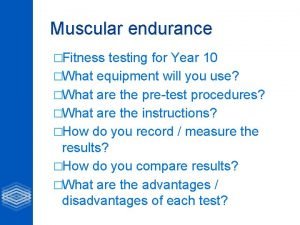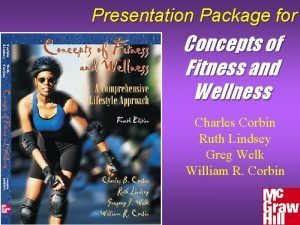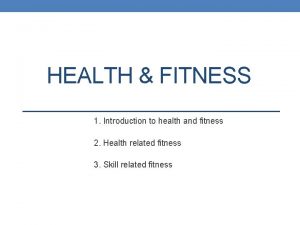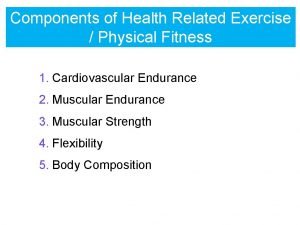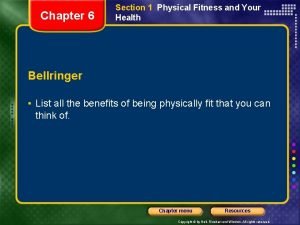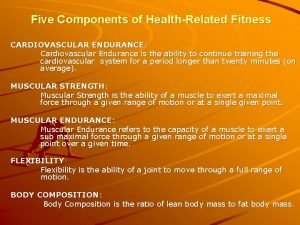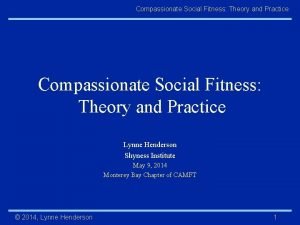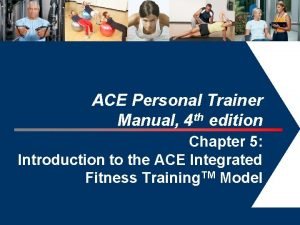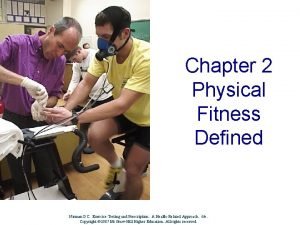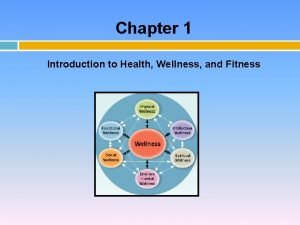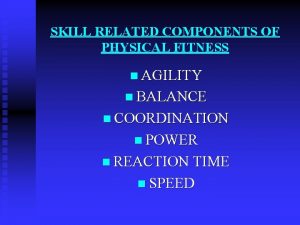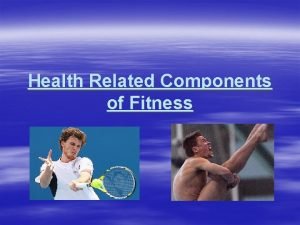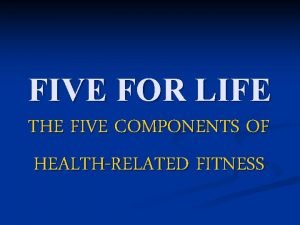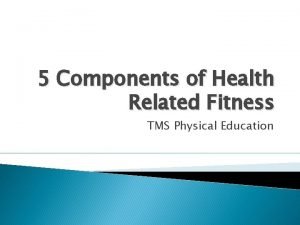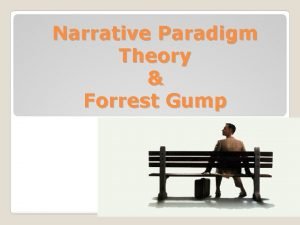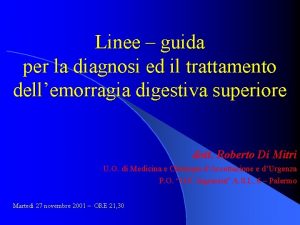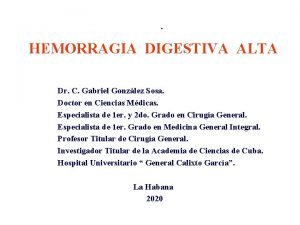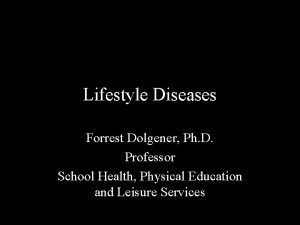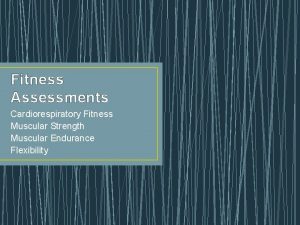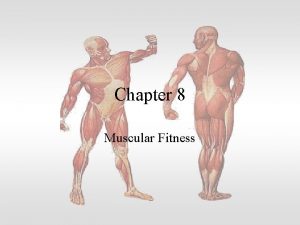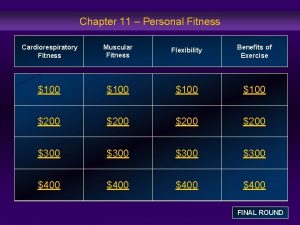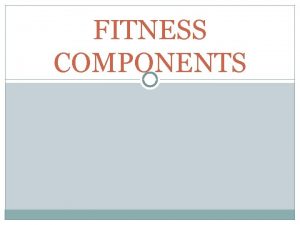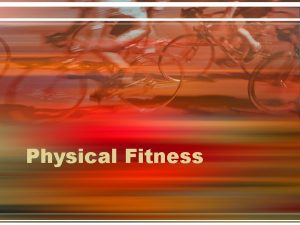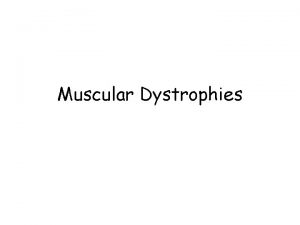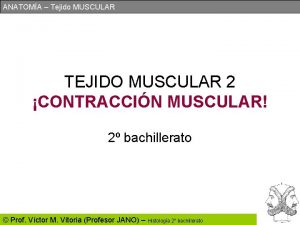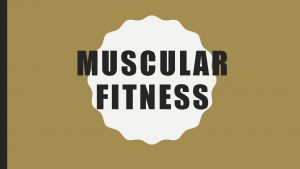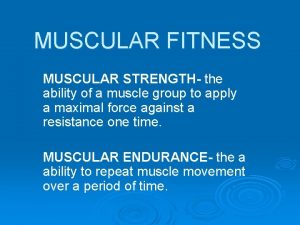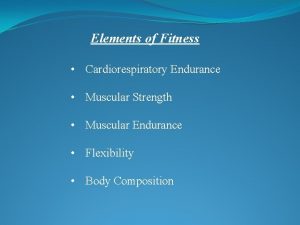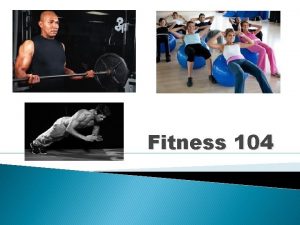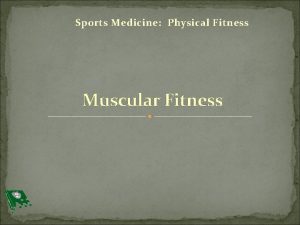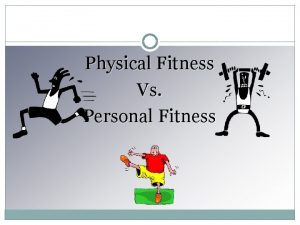Muscular Fitness Forrest Dolgener Ph D Professor Health

































- Slides: 33

Muscular Fitness Forrest Dolgener, Ph. D. Professor

Health Benefits • Increased bone density • Increased HDL-C • Increased muscle mass which increases BMR • Decreased risk of low-back syndrome • Greater stability and balance • Improved self-image

Muscular Strength • Muscular strength is the maximal force that can be generated by a specific muscle or muscle group. Muscle strength is specific to – The muscle group – Type of contraction – Speed of contraction – Joint angle

Muscular Endurance • Muscular endurance is the ability of a muscle or muscle group to develop repeated force over a period of time or to maintain a specific percentage of the maximum voluntary contraction (MVC) for a prolonged period of time.

Types of Muscle Contractions • Dynamic (a. k. a. isotonic) – Concentric • Shortening contractions • Moves mass against gravity – Eccentric • Lengthening • Resists gravity acting on a mass • Static – muscle does not change length



Gradation of Muscle Force • Increased frequency of discharge (rate coding) • Increased number of motor units recruited

Factors Determining Torque Produced by Muscle • Physiological Factors – Number of motor units recruited – Types of fibers recruited – Length of muscle • Mechanical Factors – Length of lever arm – Angle of pull



Strength Testing Modes • Static • Dynamic – Constant resistance – Variable resistance • Isokinetic

Muscular Endurance Testing Modes • Static (% of 1 RM) • Dynamic – % of 1 RM – % of body weight • Isokinetic

Fundamental Concepts of Progression • • Progressive overload Specificity Variation Periodization – Classic (linear) model – Undulating (nonlinear) model

Interaction of Loading & Reps Power? ? Strength 1 2 4 6 8 Endurance 10 12 14 16. . Repetitions Maximum Heavy(100%) Moderate (70%) Resistance Light (50%)

Program Variables • • • Muscle action Loading Training Volume Exercise selection Exercise order Rest Periods • Velocity of Muscle Action • Frequency • Free weights vs machines

Muscle Action • Novice: Concentric and eccentric • Intermediate: Concentric and eccentric • Advanced: Concentric and eccentric

Loading • Novice & Intermediate – 60 -70% of 1 RM or 8 -12 RM – 2 -10% increase for RM loading • Advanced – 80 -100% of 1 RM or 1 -5 RM – Periodized schedule – 2 -10% increase for RM loading

Training Volume • • Novice: 1 -3 sets Intermediate: 2 -3 sets Advanced: 3 -6 sets Training volume increase should be no more than 10% every 2 -4 weeks

Exercise Selection • Both single and multi-joint exercises should be used • Less risk of injury with single joint exercises • More transfer to performance with multijoint exercise

Exercise Order • When training all major muscle groups in a single session – Large muscles before small – Multi-joint before single • Split Routine – Large before small – Multi-joint before single – Rotation of agonist/antagonist

Rest Periods • For all levels – For multi-joint, high resistance and large muscle exercises: 2 -3 minutes – For single-joint, small muscle exercises or lower resistance: 1 -2 minutes • May alternate muscle groups with little or now rest in order to shorten total exercise time

Velocity of Muscle Action • Novice – Slow (2 -4 sec for each phase) – Moderate (1 -2 sec for each phase) • Intermediate should use moderate velocities • Advanced should use slow to fast (<1 sec for each phase)

Frequency • Novice should train the entire body 2 -3 days per week. • Intermediate – 2 -3 days per week for total body – 3 -4 days per week such that each muscle group is trained 1 -2 days per week • Advanced – 4 -6 days per week with 2 -3 days per week for each major muscle group – Multiple sessions per day may be used if recovery is optimized

Factors Affecting the Ability to Hypertrophy Muscle • • Muscle Type Genetics Hormones Nutrition – General nutrition – Supplementation • Training

MODEL OF NEURAL AND HYPERTROPHIC FACTORS

Training for Hypertrophy • Loading – 70 -100% of 1 RM – 1 -12 Reps with majority 6 -12 • 3 -6 sets • Periodized • Rest periods of 1 -2 minutes except in heavy loading of core exercises when 2 -3 minutes of rest are recommended

Training for Muscular Power • Power = Work/Time • Power is optimized using more explosive movements on top of a good strength base • Light to moderate loading (30 -60% 1 RM) performed at an explosive velocity

Factors Determining Flexibility of a Joint • • Joint capsule – 47% Muscle and its fascia – 41% Tendons and ligaments – 10% Skin – 2%

Types of Stretching • Ballistic (dynamic) Stretching • Static Stretching • PNF Stretching

Flexibility Prescription • • Mode: Static or PNF Number of exercises: Depends Frequency: 2 -3 days per week Intensity: to point of obvious tension but not pain • Duration: 10 -30 seconds • Repetitions: 3 -4


 What is skill-related fitness? *
What is skill-related fitness? * Difference between strength and endurance
Difference between strength and endurance Promotion from assistant to associate professor
Promotion from assistant to associate professor Muscular strength fitness test
Muscular strength fitness test Health and fitness presentation
Health and fitness presentation Introduction of health and fitness
Introduction of health and fitness Exercise physiology for health, fitness, and performance
Exercise physiology for health, fitness, and performance Health fitness concepts
Health fitness concepts Five components of health related fitness
Five components of health related fitness Section physical fitness and your health
Section physical fitness and your health Pro health & fitness center
Pro health & fitness center What is cardiovascular endurance in health related fitness
What is cardiovascular endurance in health related fitness Stairway to lifetime fitness health and wellness
Stairway to lifetime fitness health and wellness Hexagon agility test clockwise time average
Hexagon agility test clockwise time average Augusta health lifetime fitness
Augusta health lifetime fitness Vcert health and fitness
Vcert health and fitness Stairway to lifetime fitness health and wellness
Stairway to lifetime fitness health and wellness Physical fitness grade 7
Physical fitness grade 7 Social fitness training
Social fitness training Ace ift
Ace ift Health fitness definition
Health fitness definition Health related physical fitness definition
Health related physical fitness definition Introduction of health and fitness
Introduction of health and fitness Health related fitness
Health related fitness Agility
Agility Components of health related fitness
Components of health related fitness Five components of health related fitness
Five components of health related fitness 5 components of physical education
5 components of physical education Forrest mobley
Forrest mobley Plot of forrest gump
Plot of forrest gump Ulcera forrest iii
Ulcera forrest iii Forrest clasificacion
Forrest clasificacion Forrest gump presentation
Forrest gump presentation Forrest gump plot summary
Forrest gump plot summary



